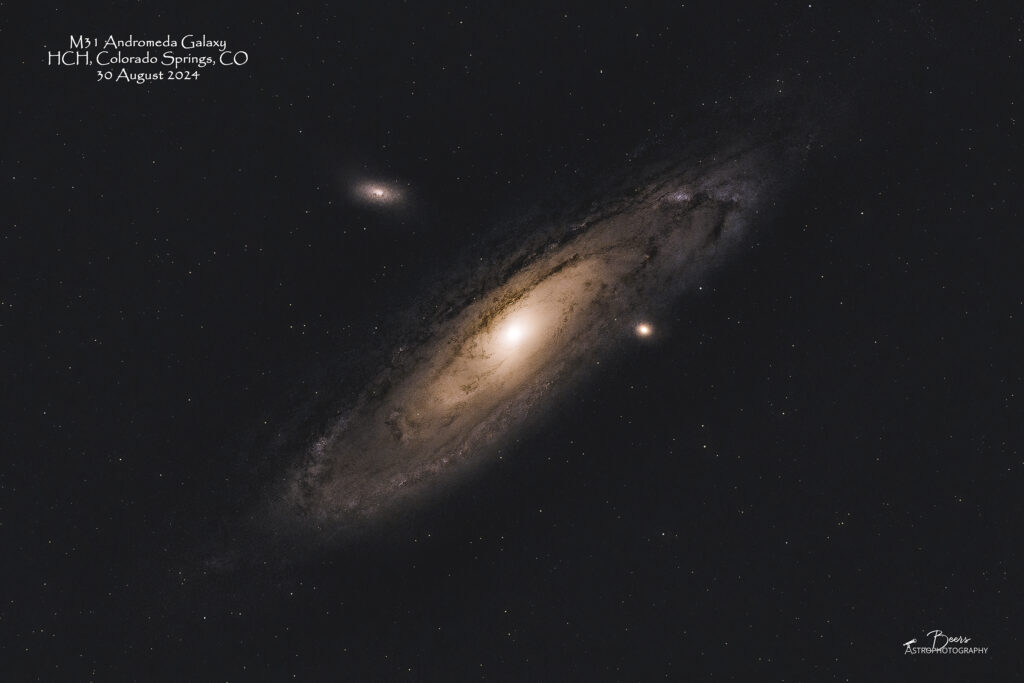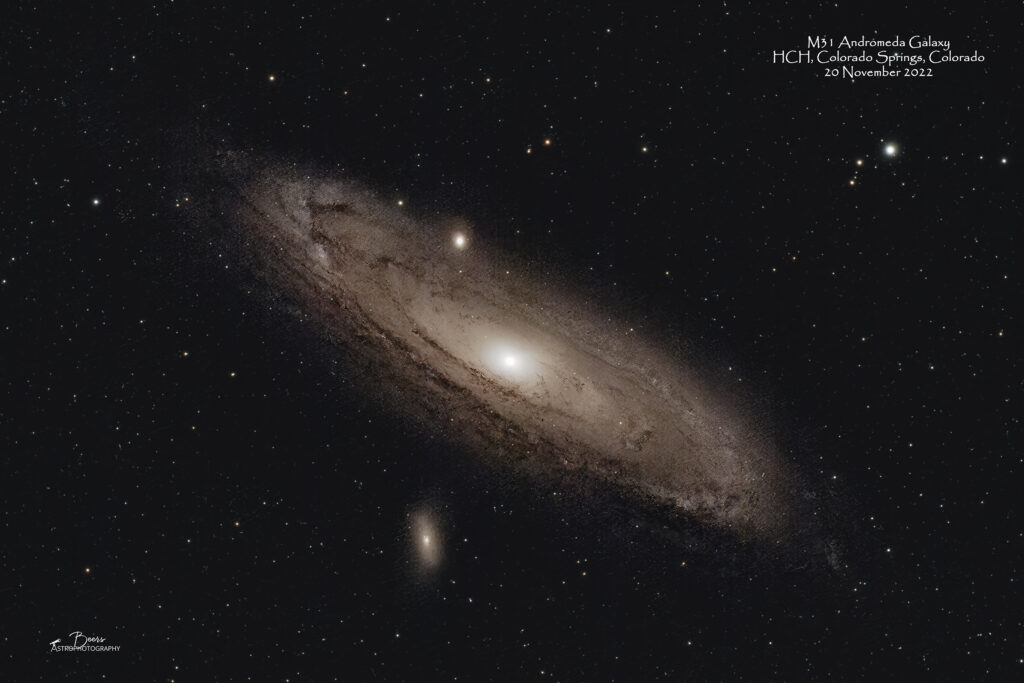
Fun facts
M31 Andromeda Galaxy is a barred spiral galaxy and is the closest major galaxy to the Milky Way, where the Solar System resides. It was originally named the Andromeda Nebula and is cataloged as Messier 31, M31, and NGC 224. Andromeda has a diameter of about 46.56 kiloparsecs (152,000 light-years) and is approximately 765 kpc (2.5 million light-years) from Earth. The galaxy’s name stems from the area of Earth’s sky in which it appears, the constellation of Andromeda, which itself is named after the princess who was the wife of Perseus in Greek mythology.
The virial mass of the Andromeda Galaxy is of the same order of magnitude as that of the Milky Way, at 1 trillion solar masses (2.0×1042 kilograms). The mass of either galaxy is difficult to estimate with any accuracy, but it was long thought that the Andromeda Galaxy was more massive than the Milky Way by a margin of some 25% to 50%. The Andromeda Galaxy has a diameter of about 46.56 kpc (152,000 ly), making it the largest member of the Local Group of galaxies in terms of extension.
The Milky Way and Andromeda galaxies are expected to collide in around 4–5 billion years, merging to potentially form a giant elliptical galaxy or a large lenticular galaxy. With an apparent magnitude of 3.4, the Andromeda Galaxy is among the brightest of the Messier objects, and is visible to the naked eye from Earth on moonless nights, even when viewed from areas with moderate light pollution.
Other Catalog Designations: M31, NGC 224
Subtype: Barred Spiral Galaxy
Distance from Earth: 2.5 million light years
Size: 152,000 light years
Constellation: Andromeda
{ From: https://en.wikipedia.org/wiki/Andromeda_Galaxy
Capture Notes
Motivated by reprocessing 2022-gathered M31 data for neighbor Sandy for a print as a thank-you for her help in the great Zeus escape last month (see below the reprocessed and original 2022 captured/processed image), I decided to reimage M31 to gather fresh data.
I started the night with the SC-LPro EAF step size test. When I ran the step size experiment, I did the math wrong, dividing by (steps-1), rather than (steps-1)/2 coming up with a step size of 87.5 – 100 (depending upon which end of the 3-5x out of focus I used). I decided to go with step size = 100, since smaller step sizes had proven problematic in the past. I ran a manually-started autofocus routine with step size = 100, it resolved at 7214, HFR=1.9 so I went with the step size =100 for the SC-LPro configuration. {BTW, the next day when I entered all the data into a spreadsheet and did the math correctly, I came up with a step size of 175 – concluding that the step size goes with the filter regardless of the telescope.}
I collected data 30Aug, 2230MDT – 31Aug, 0315, capturing all the planned 300-second, 60-second, and 2×180 second frames. When I went outside to supervise the meridian flip (crossed meridian at 03:03MDT, flip was scheduled for 20 minutes past meridian (i.e., 03:23)), I discovered that SGP had shut down. When I reopened SGP and the sequence, the gear was still connected and in collection position, but data was not being collected (i.e., had shut down but not parked upon failure). So, apparently something had gone wrong with the programmed meridian flip. I shut down the equipment and got everything restarted at 03:31MDT and ran until I ended the sequence at astronomical twilight at 05:26MDT.
Sequence Plan (30Aug2024): Gain: 158, Temp: -0°C, offset=30. 40x5min, 37x3min, 50x1min. Captured 30Aug2024, 22:25MDT – 31Aug2024, 05:26MDT. Total exposure time: 361min, 6:01hrs (ASI2400-SC-LPro)
Equipment
All equipment controlled by HP Probook running Sequence Generator Pro v4.4.0.1339.
Imaging (ASI2400-SC-LPro): ZWO ASI2400MC imaging camera on (Southern Cross) Askar FRA600 108mm f/5.6 Quintuplet Petzval Flat-Field Astrograph, Optolong L-Pro LP filter (LPro)
Autofocuser: ZWO EAF Electronic Automatic Focuser – Standard (New 5V Version) (EAF-5V-STD)
Mount: Rainbow Astro RST-300 (controlled by iHubo ASCOM driver)
Polar alignment: QHYCCD camera (controlled by Polemaster for polar alignment)
Autoguiding: Orion 60mm Multi-Use Guide Scope with Orion StarShoot AutoGuider Pro Mono Astrophotography Camera (controlled by PHD2)
Capture: 30 August 2024
Shooting location: Colorado Springs, Colorado
Processing: Captured in SGP, stacked in APP (HaOIII Color), star removal with Starnet++, processing with LR/PS
Other Images of M31 Andromeda Galaxy
This is a reprocessed version of the 20 Nov 2022 image of M31. The reprocessing was accomplished shortly before the 30 August recapture shown above to develop a print-worthy version. Reprocessing the 20Nov2022 data using my current processing techniques (most importantly, minimizing the star field to allow the Andromeda Galaxy to “pop” more in the image. The need for a print was motivated by the need to send a HUGE thank-you to our neighbor, Sandy, who was instrumental in rescuing Zeus from his great escape during a severe thunderstorm on 5 August 2024.

This was the original 20 November 2022 captured and processed image and its capture notes, shown above as it was reprocessed on 28 August 2024

M31 Andromeda; Captured at HCH, Colorado Springs, Colorado; 20 November 2022
Capture Notes
Debated about imaging the NGC1909 Witches Head Nebula, but decided on M31 Andromeda as it was at its peak of viewing hours while NGC1909 has opportunities until March, allowing a dark skies opportunity (which never happened from September 2022 until June 2023!). Had some strange issues with start-up, perhaps because I reaccomplished the framing & mosaic tool in the sequence plan – SGP failed to save the image to disk, then wouldn’t start the PHD2 calibration process. I ended up recreating the entire sequence on the laptop from its RaAskarRC135E profile – needed to go into SGP and clean up the equipment profiles and create a clean RaSC with RC135E, so there’s no doubt on which equipment is included in the profile. Also, at the end of the session, although it theoretically had 45 minutes until the 20 degree horizon, ran into the corner of the house at about 0215 – I need to determine what the “real” horizon is for the west side of HCH patio shooting (turns out that, depending upon the azimuth, it is as much as 30 degrees).
Sequence plan: ISO1600, 137x3min; captured 20Nov2022, 1843MDT – 21Nov2022, 0211MST; Total=6:51hrs.
Equipment
Polar alignment: QHYCCD camera (controlled by Polemaster)
Imaging stream: Askar FRA600, Canon EOS Ra with Optolong LPro light pollution filter
Mount: Rainbow Astro RC-135E (controlled by iHubo)
Autoguider: Orion 60mm Multi-Use Guide Scope, Orion StarShoot AutoGuider Pro Mono Astrophotography Camera (controlled by PHD2)
Equipment controlled by HP Probook (DSO CTRL 1) running Sequence Generator Pro v3.2.0.660.
Capture: 20 November 2022
Shooting location: Colorado Springs, Colorado
Processing: Stacked in APP, processed in LR/PS.
